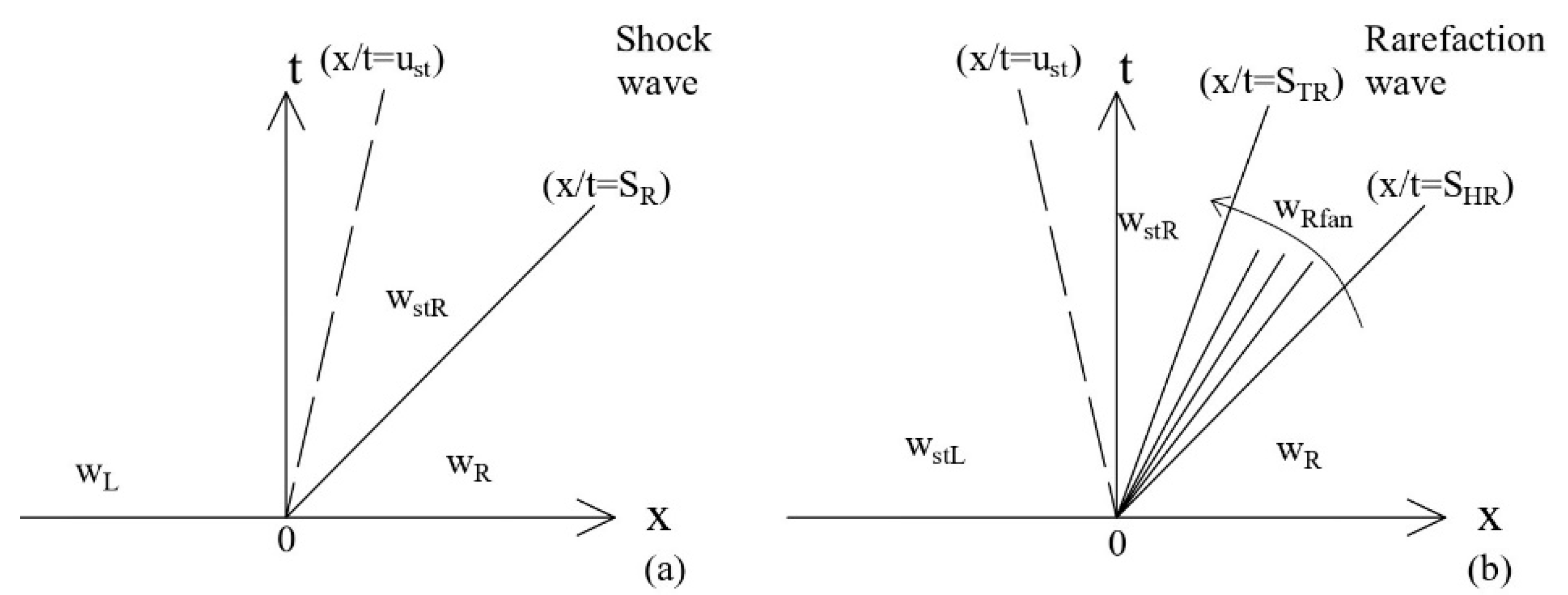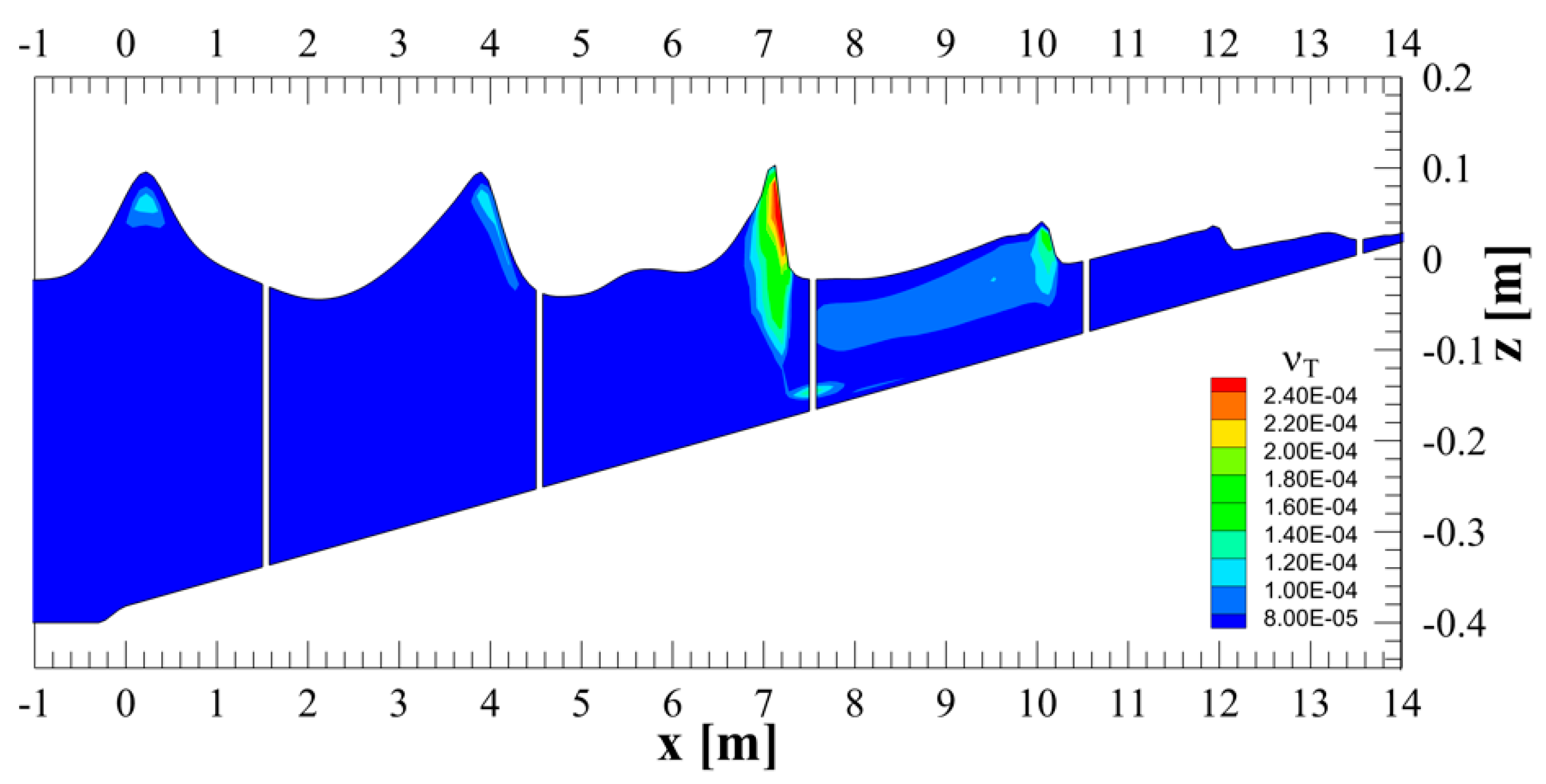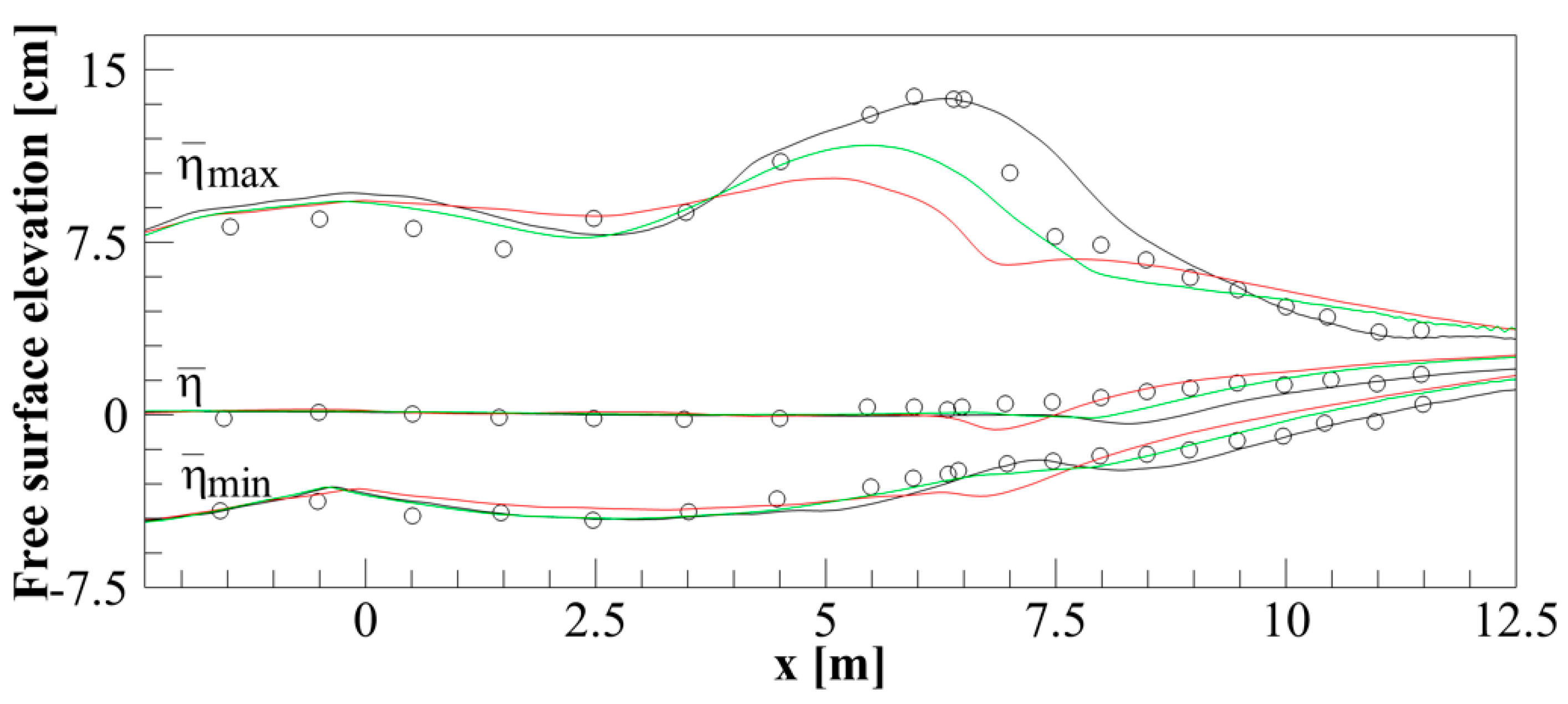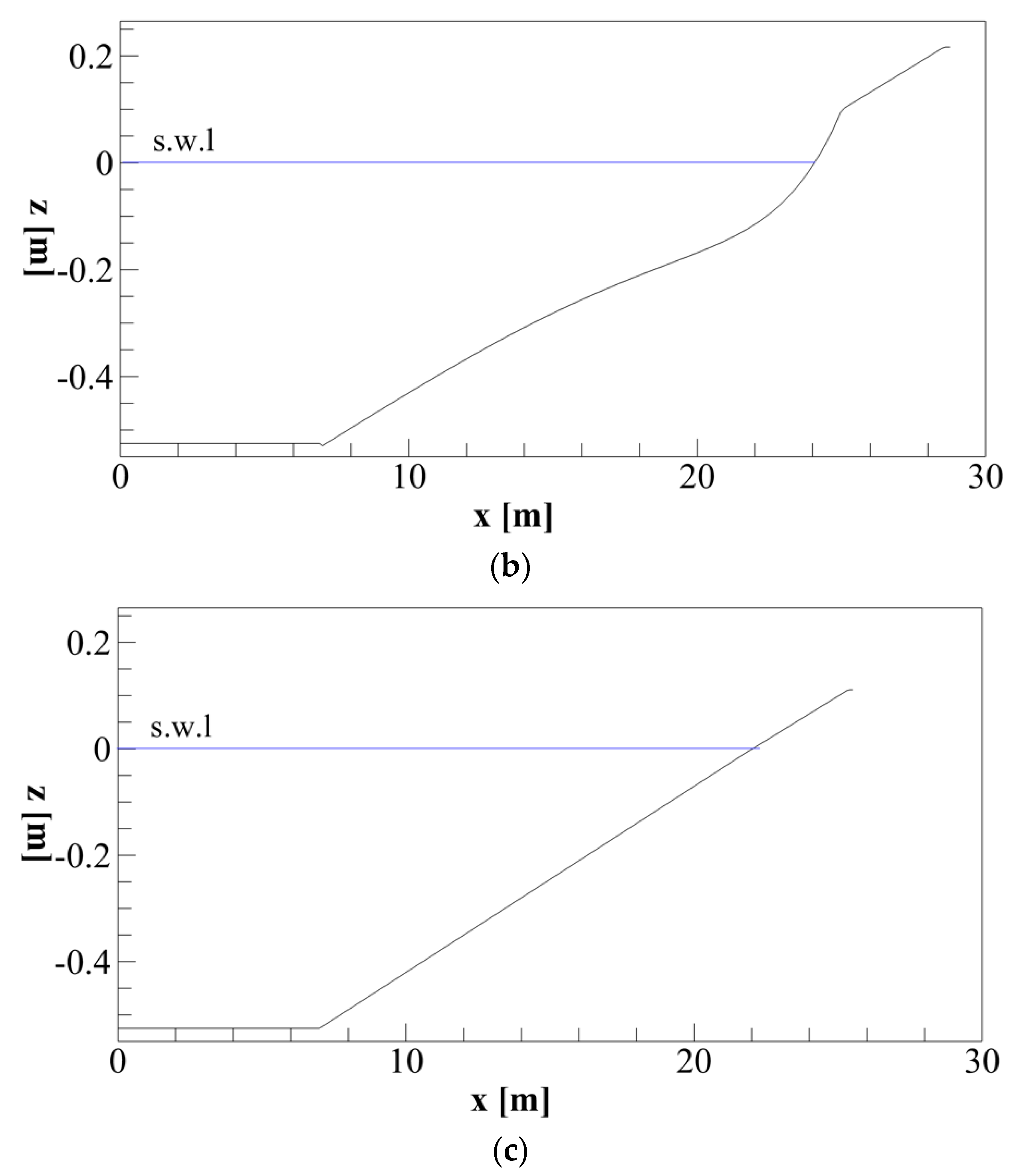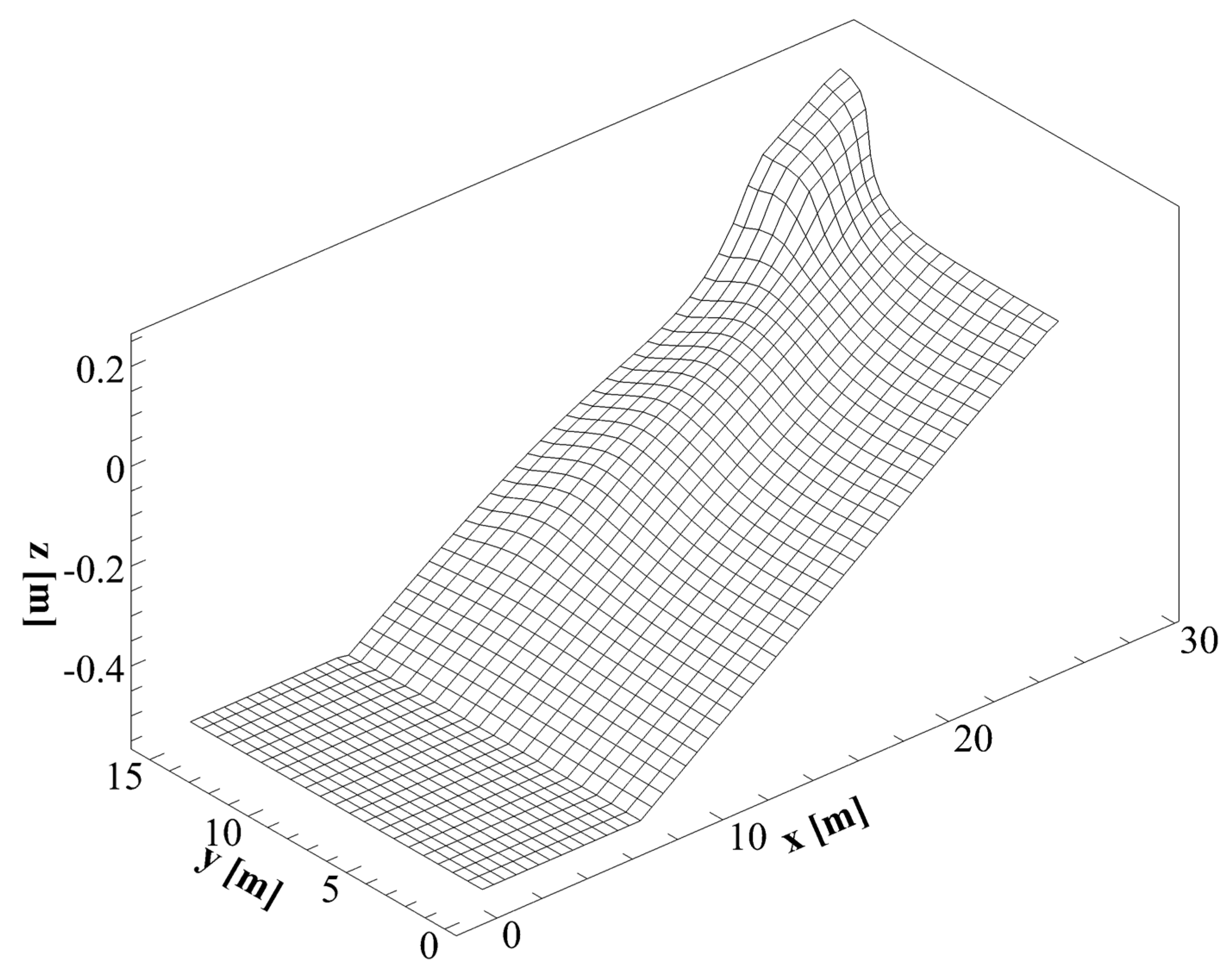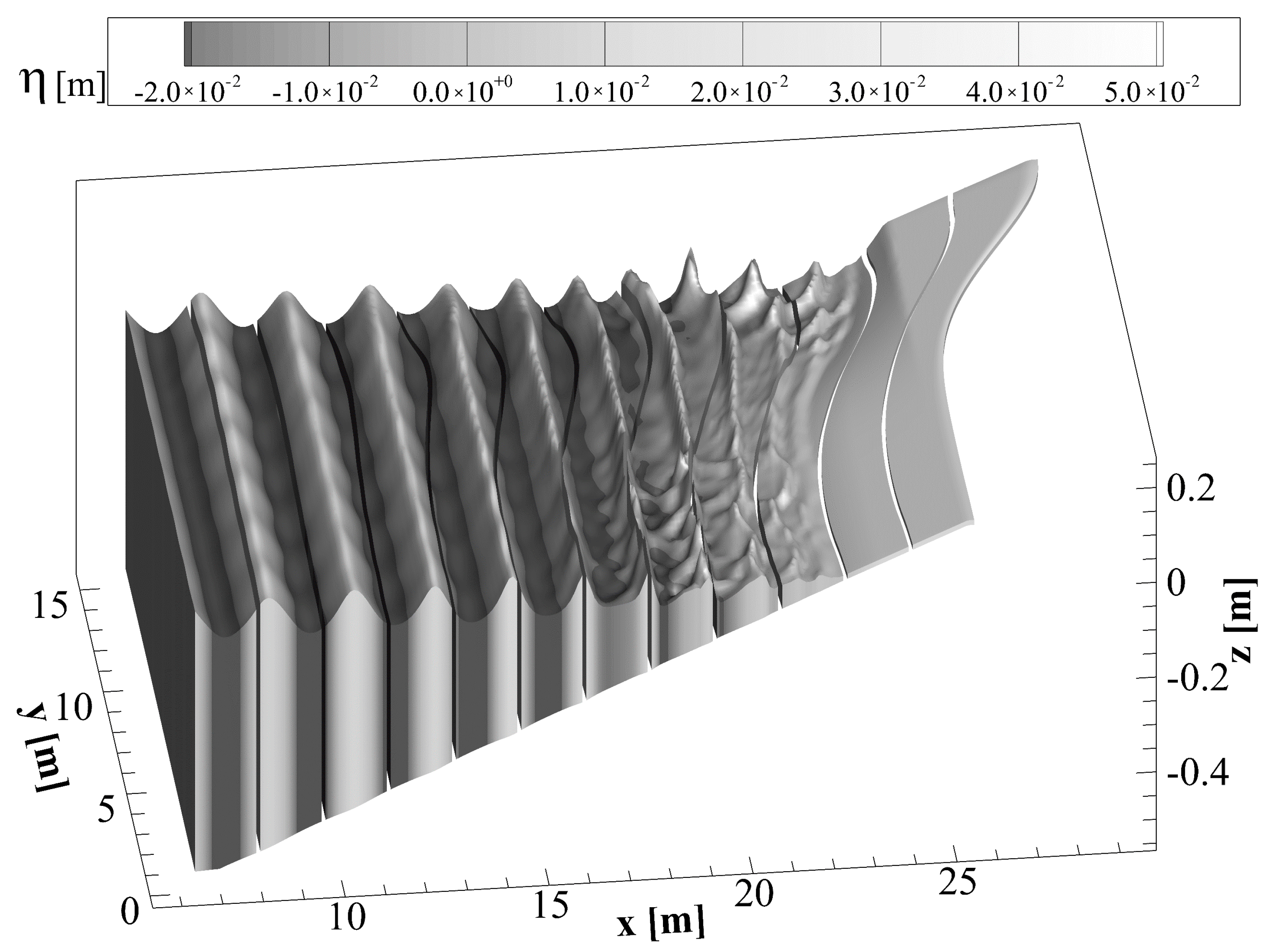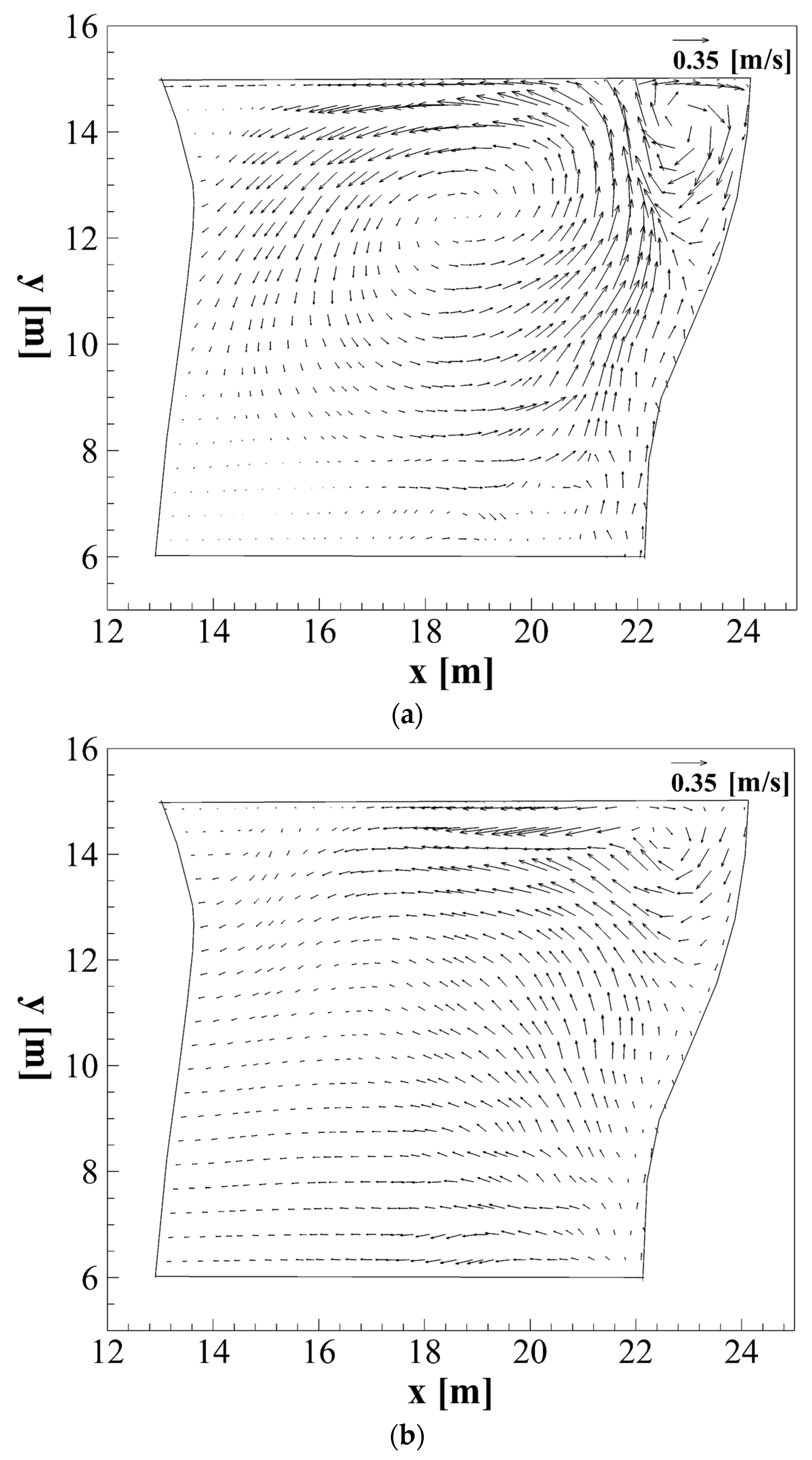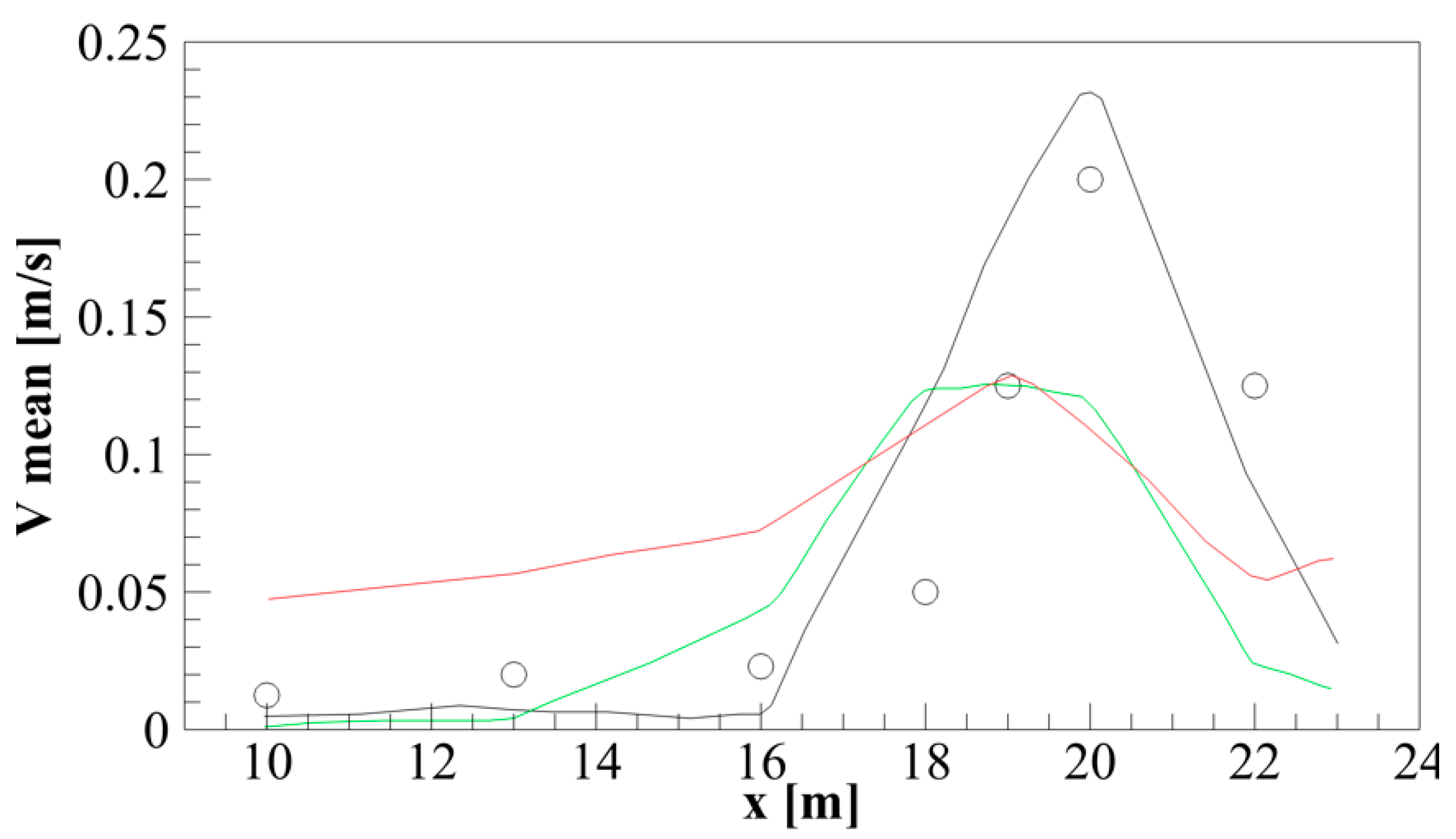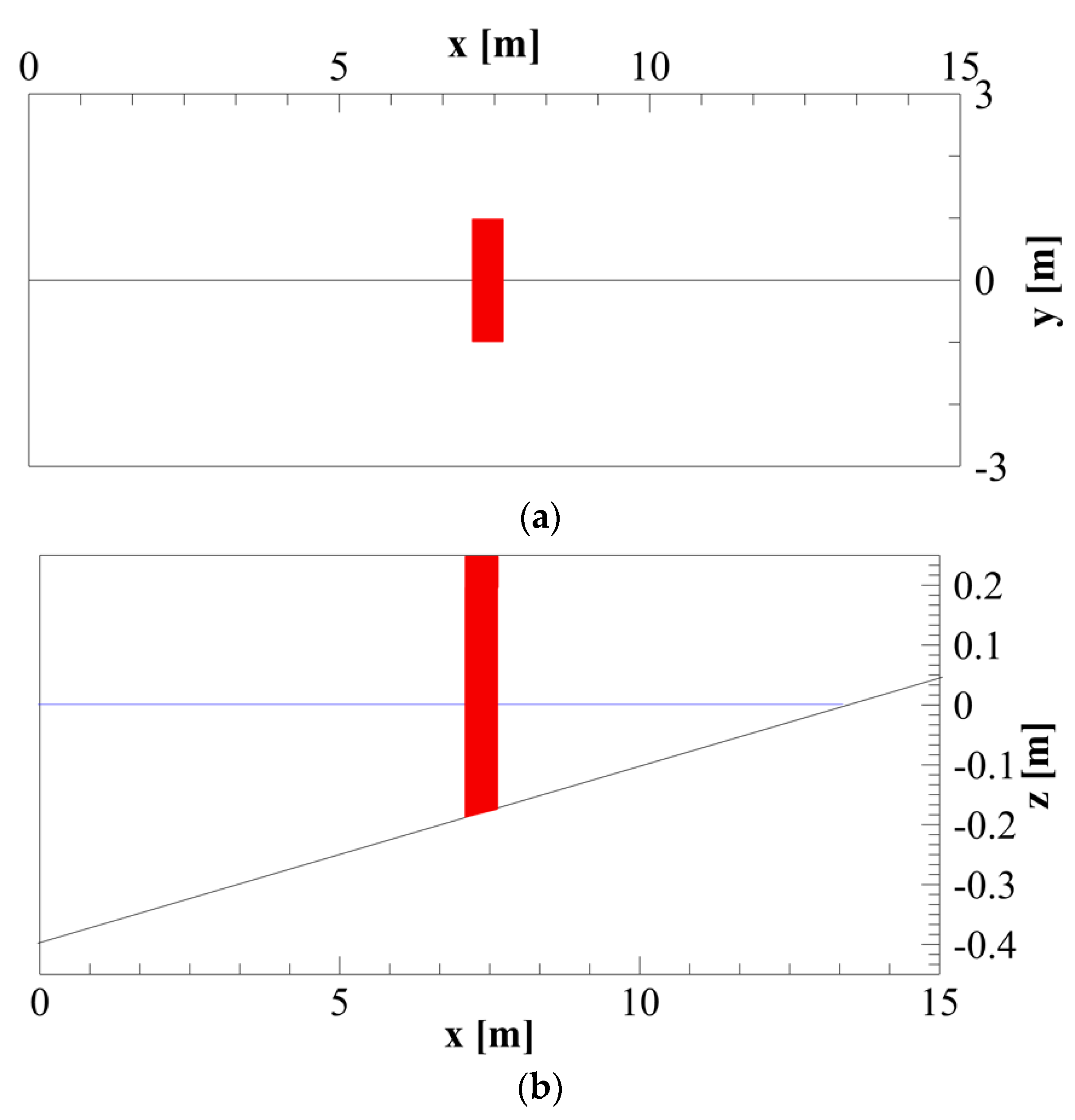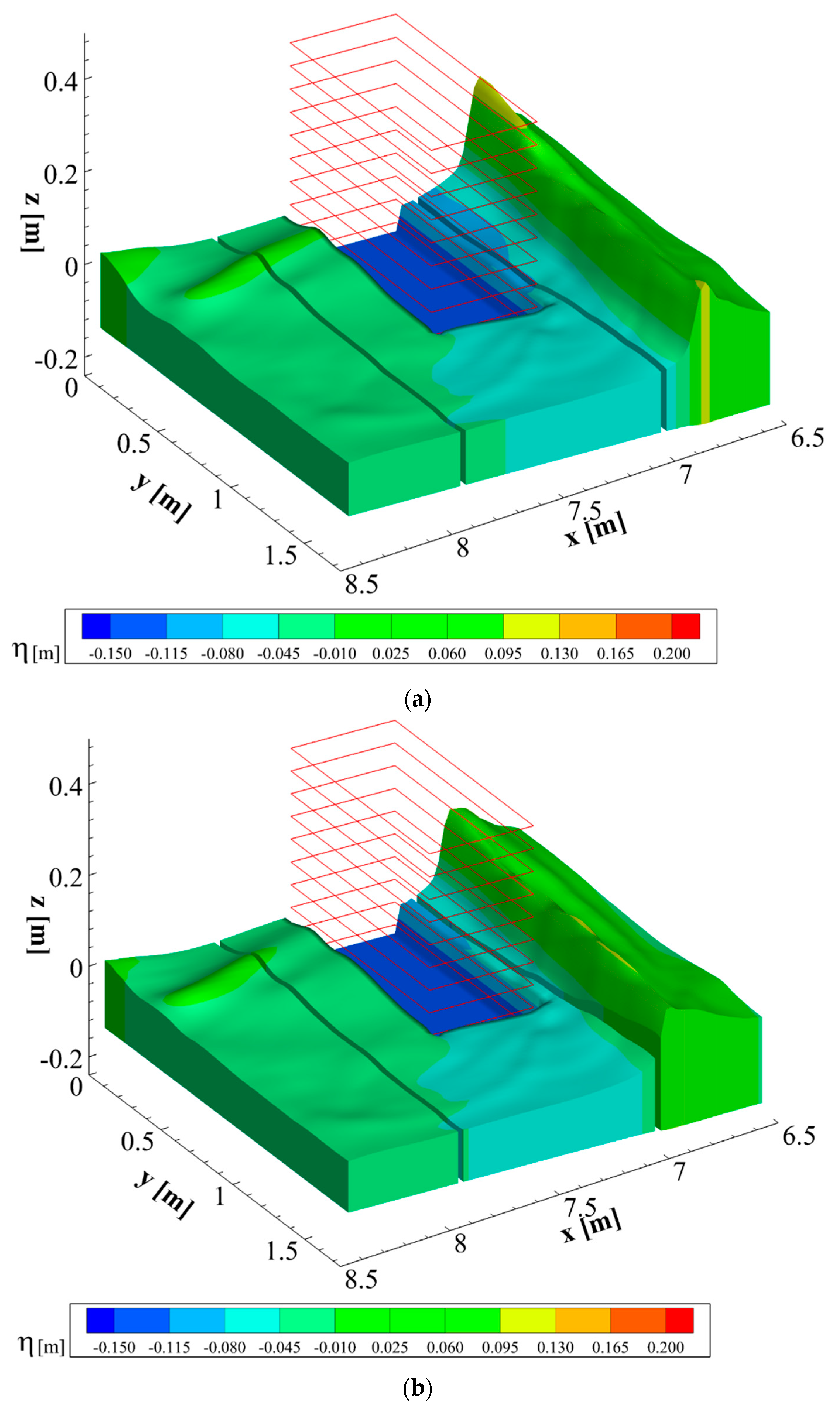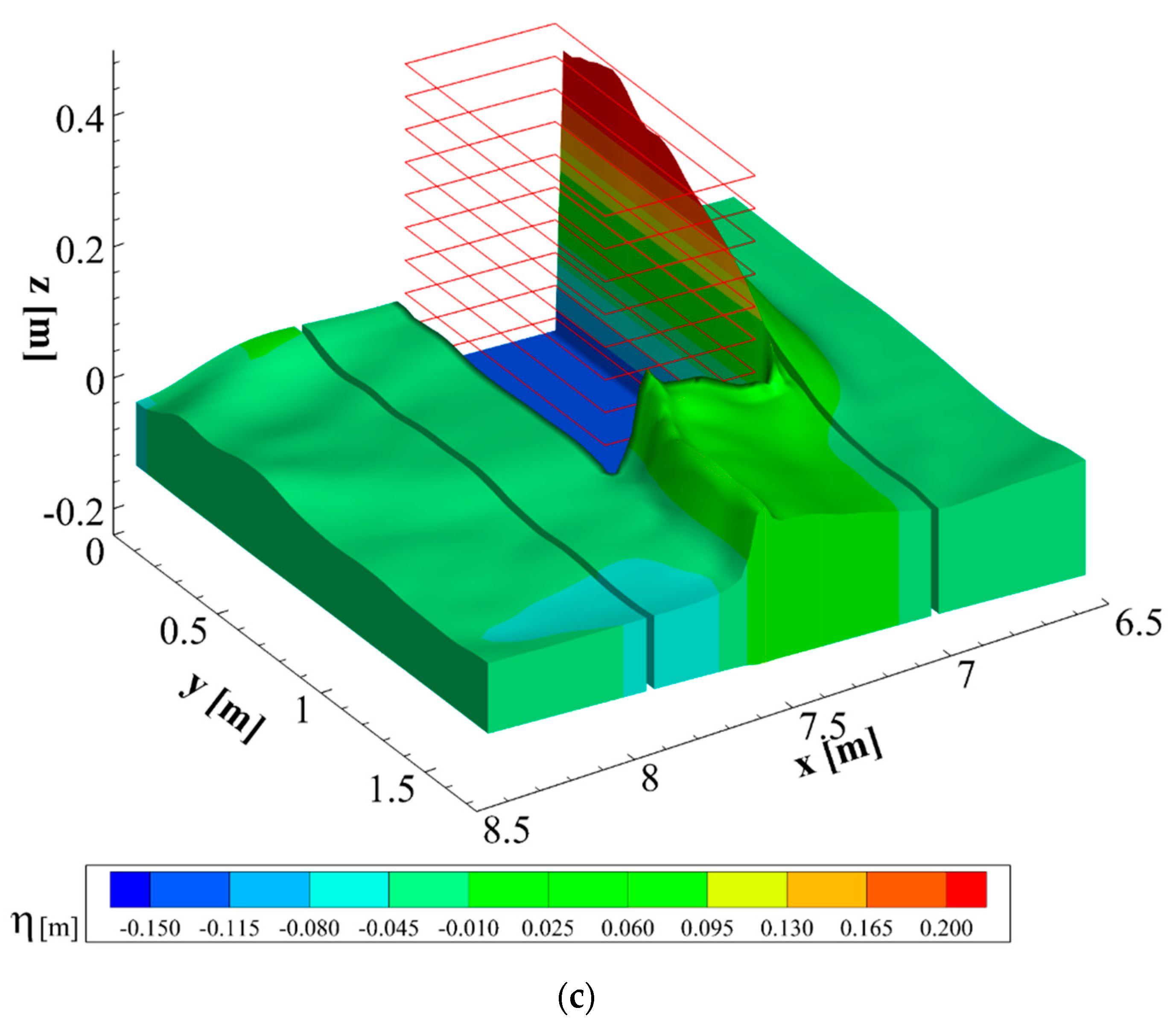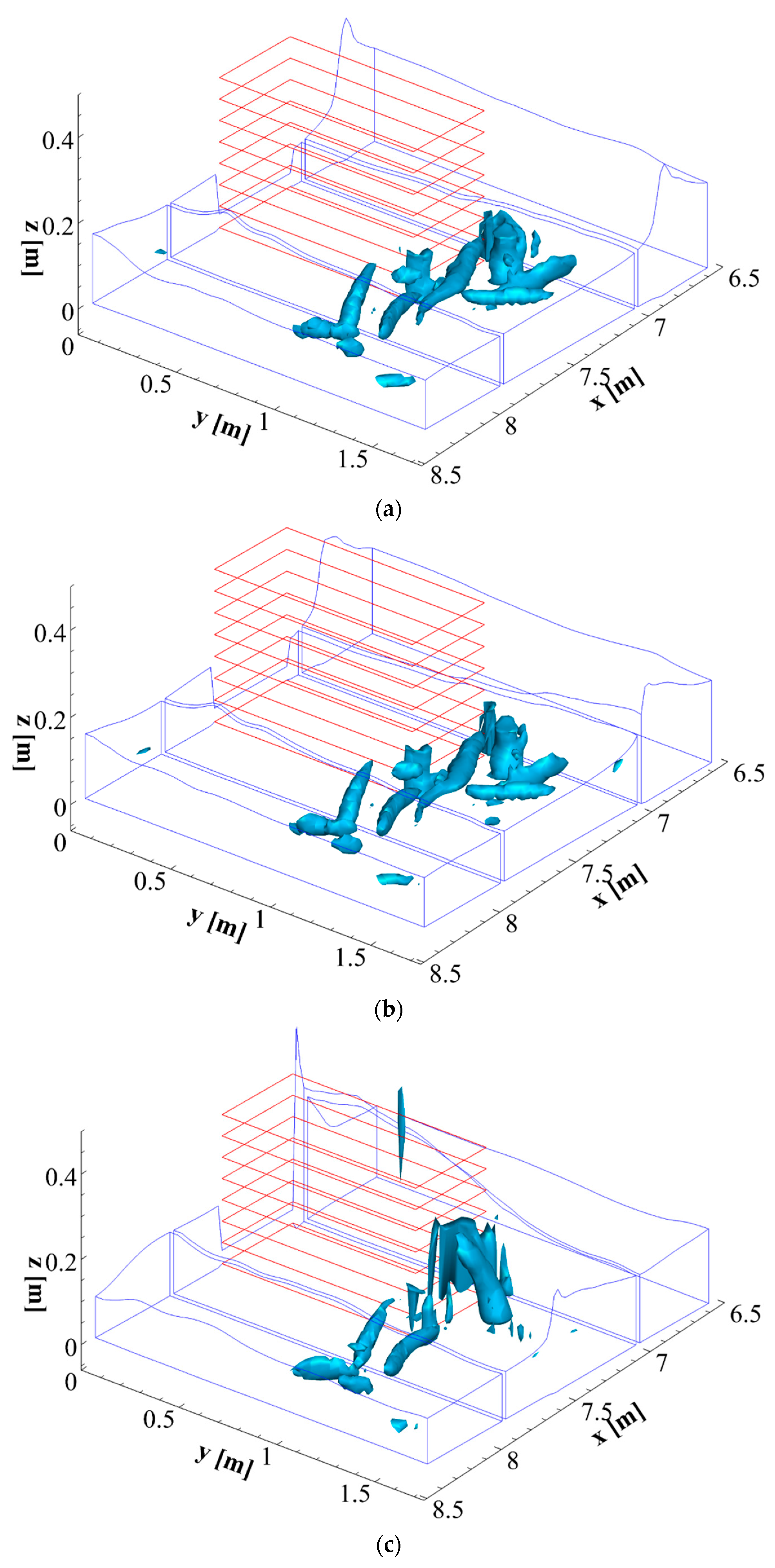3.2. Time Advancing of the Numerical Solution
Step 1
At the generic time
, the point values of the conserved variables at the cell faces are reconstructed, starting from their cell-average values, using an original procedure (described in
Section 3.3) that is based on a high-order combination of polynomials centered in the computational cell. After the reconstruction procedure, on the cell face defined by indexes
, two different point values of the generic conserved variables are obtained,
and
; the first one indicates the reconstruction obtained by the combination of polynomials centered in cell
; the second one indicates the reconstruction obtained by the combination of polynomials centered in cell
(analogously on the other cell faces). At the end of this step, a couple of point values of the conserved variables on each cell face are obtained:
Step 2
At every cell face, the point values of the conserved variables obtained in the previous step are used as initial values of a local Riemann problem in which two constant states are separated by a discontinuity. The local Riemann problem is solved in exact form. For this purpose, at the center of every cell face, a transformation of the basis vectors is carried out, to obtain a local system in which one of the basis vectors is normal to the cell face and the other two lie on the plane of the cell face. By expressing the point values of the vector components with respect to the above local system of basis vectors, the local Riemann problem at each cell face can be solved as a Cartesian Riemann problem. The exact solution of the local Riemann problem provides the updated point values of the conserved variables on the cell faces. After a new basis vector transformation, from the local Cartesian one to the contravariant one, we obtain the contravariant components of the updated point values of the conserved variables on every cell face:
where the superscript
indicates point values obtained using the exact Riemann solver.
Step 3
The point values obtained in the previous step are introduced in the discretized form of the momentum balance equation (Equation (7)) in which the dynamic component of the pressure is omitted. The resulting equation provides an approximate field,, (called predictor field and denoted by the asterisk) of the cell average of the conserved variables . This predictor field represents an approximation of the final vector field , since it is obtained without taking into account the dynamic component of the pressure.
Step 4
Differently from what is done in [
3], in the proposed conservative scheme the predictor field
is directly used to define the known right-hand side of a Poisson-like equation,
in which
is an unknown potential scalar function. It must be noted that the right-hand side of Equation (10) is expressed directly in terms of the conserved variables
. Consequently, the scalar field of
is calculated by numerically solving Equation (10), without the need of calculating an approximate field of the water depth,
, and primitive variables,
. Equation (10) is discretized by the same finite volume–finite difference method proposed by [
3] and is numerically solved for
by an iterative method in which a four-color zebra, a line-by-line Gauss–Seidel procedure, and a multigrid technique are adopted.
Step 5
The gradient of the potential scalar
is used to correct the field of the conserved variables, both at the center of the computational cells and at the center of the cell faces:
The final field of the conserved variables, , takes into account the dynamic component of the pressure and is associated with a divergence-free flow velocity field (unless the approximation error by which the Poisson equation is numerically solved). By this predictor–corrector procedure, the proposed finite volume conserved numerical scheme makes use exclusively of conserved variables and, consequently, can converge to the weak solution with discontinuity, with a correct shock-speed propagation.
Step 6
The corrected values of the conserved variables, , at the center of the vertical cell faces (defined by indexes and ) are associated with a divergence-free flow velocity field) and are introduced in the discretized integral over the water column of the continuity equation (Equation (6), to update the cell average of the water depth .
Step 7
The new position of the free surface is used to update the coordinates of all the computational cells, the metric terms associated to the time-dependent curvilinear coordinate system, and the contravariant velocity component of the moving curvilinear vertical coordinate, which is given by
3.3. The Proposed Fifth-Order Wave-Targeted Essentially Non-Oscillatory Reconstruction Technique
In this section, we propose an original high-order technique for the reconstruction of the point values of the conserved variables at the center of the cell faces. The high-order shock-capturing numerical scheme proposed in this paper is based on the idea that a breaking wave can be represented as a discontinuity of the numerical solution. It is known [
9] that in the numerical solution with discontinuities, spurious numerical oscillation can arise close to the discontinuities and can propagate on the solution, compromising the entire result. As emphasized by Toro [
9], the numerical schemes that ensure a non-oscillatory behavior are first-order accurate.
The shock-capturing numerical schemes proposed by [
1,
2,
3,
4] for the three-dimensional simulation of breaking waves are at most second-order accurate, where the solution is smooth and degrades to first-order accuracy near the discontinuities. The use of such low-order TVD schemes proposed in the literature is mainly due to the need to limit the spurious oscillation that can take place in the numerical solution.
As demonstrated in this paper, in the three-dimensional numerical simulation of breaking waves, second-order TVD shock-capturing schemes introduce too much numerical energy dissipation. The excessive numerical energy dissipation produces an underestimation of the wave height evolution in the shoaling phase, a wrong location of the initial wave breaking point, and an excessive reduction in the wave height in the surf zone. Further developments of second-order TVD methods are the WENO methods [
10,
11]. In the fifth-order upwind WENO schemes [
11], to reconstruct the point values of a generic quantity in the face of a given computational cell
, three different second-order polynomials are defined, each one centered on a different cell in the neighborhood of
. In the above WENO scheme, the point value is obtained using a convex combination of the three polynomials. In such a convex combination, the initial weight of each polynomial is defined to obtain the maximum order of accuracy of the reconstruction. During the numerical simulation, the weight of each polynomial can be dynamically modified with respect to the original one, in order to reduce or increase its relative weight in the convex combination. The modification of the weights of the combination, with respect to the original values, produces a lower-order reconstruction that introduce numerical energy dissipation in the numerical solution. WENO schemes aim to maintain a high order of accuracy where the solution is smooth and to introduce numerical energy dissipation near the discontinuities, to limit the spurious oscillations. As shown in this paper, the use of a shock-capturing scheme based on fifth-order WENO reconstructions for the simulation of breaking waves, allows for only partially overcoming the drawbacks of shock-capturing schemes based on second-order TVD reconstructions. Numerical results of breaking waves carried out by a fifth-order upwind WENO scheme are in better agreement with the experimental results (with respect to those obtained using a second-order TVD method), but show an underestimation of the wave height evolution in the shoaling zone, a wrong location of the initial breaking point, and an excessive reduction in the wave height in the surf zone. This is due to an excess of numerical energy dissipation introduced by the WENO scheme in the shoaling zone before the breaking point and in the entire wave breaking zone. Such excess numerical energy dissipation is due to the criterion by which the WENO schemes modify the weight of each polynomial of the convex combination. In the WENO schemes, the modification of the weights with respect to their original values is determined exclusively as a function of the smoothness of the polynomials. In the shoaling zone before wave breaking and in the entire surf zone, the steep wave fronts produce high gradients of the conserved variables (
and
). In such a zone, in the presence of the above-mentioned high gradients, the WENO schemes consider the numerical solution as irregular and, consequently, modify the weights with respect to the original one. These modifications produce low-order reconstruction approximations that introduce too much numerical energy dissipation in the numerical solution.
It must be emphasized that the steepest fronts take place at the wave breaking, where the turbulence phenomena are more significant. At these steep fronts, the reconstruction procedure must introduce small numerical energy dissipation, to leave the task of dissipating the adequate amount of kinetic energy to the turbulence model. In the surf zone, the wave front is followed by a wave tail characterized by small energy dissipation due to turbulence. In such a portion of the wave, the reconstruction procedure must introduce the numerical energy dissipation required to contain the spurious oscillations that take place on the free surface at the steep wave fronts. In the present paper, we follow the conceptual line of the so-called targeted essentially non-oscillatory (TENO) schemes, first presented in [
12] and improved by [
13], and we propose an original high-order TENO scheme specifically designed for three-dimensional simulation of breaking waves, called wave-targeted essentially non-oscillatory (WTENO) scheme. The original WTENO scheme is based on three main elements. The first one is the definition of three different second-order polynomials, each one candidate to approximate the point value of the conserved variable on the faces of the generic computational cell
. The second main element is the definition of a regularity function, associated with each polynomial, which depends on the smoothness of the polynomials. The third main element of the proposed reconstruction technique is the definition of a dynamic threshold, common to the three polynomials, which varies as a function of both the smoothness of the polynomials and the steepness of the wave front. At every instant of the numerical simulation and at every point of the computational domain, the comparison between the regularity function and the dynamic threshold determines whether only one, two, or all the three candidate polynomials participate in the given reconstruction of the point values. In the case in which all the polynomials participate in the reconstruction, the maximum order of accuracy of the reconstruction is reached (fifth order), since the calculated point value is equivalent to the one obtained using a fourth-order polynomial defined on the stencil of five contiguous cells centered on the cell
. In the case in which only one or two polynomials participate in the reconstruction, the order of accuracy of the reconstruction reduces and the numerical energy dissipation introduced in the simulation by the numerical scheme increases. In the proposed WTENO scheme, the regularity function and the dynamic threshold are defined in such a way as to guarantee good non-oscillatory properties of the numerical scheme and avoid the excessive numerical energy dissipation produced by reconstruction techniques commonly used in the literature, such as TVD or WENO. The purpose of the proposed reconstruction procedure is to limit the numerical energy dissipation of energy introduced by the numerical scheme on the steep wave fronts (where the energy dissipation is left to the turbulence model) and ensure an adequate numerical energy dissipation on the non-breaking wave fronts and wave tails (where the energy dissipation due to the turbulence is lower and occurs mainly near the bottom).
In the three-dimensional finite volume proposed in this paper, the cell average value of the generic conserved variable is defined by the integral of the given variable over the volume of the computational cell. The reconstruction procedure consists in calculating the point values of each conserved variable on the center of every computational cell face, starting from the integral of the given conserved variable over the cell volume. In the proposed numerical model, we define a time-dependent coordinate transformation that allows us to transform the computational cells that in the physical space have an irregular and time-varying shape into computational cells that in the transformed space have a regular and fixed shape. In the transformed space, the integral of the conserved variables over the cell volume is defined by three consecutive one-dimensional integrals, each one defined on a single coordinate line. This makes it possible to define a three-dimensional reconstruction procedure for the calculation of the point values of the conserved variables that consists of three consecutive one-dimensional reconstructions, each one relative to a single coordinate line (dimension by dimension reconstructions).
In the first step of the procedure, which is carried out along coordinate , the first level of reconstruction allows for passing from the values of the given variable averaged over the volume of the computational cell to the values of the same variable averaged over a surface on which only coordinates and vary. The values obtained in the first step are used as starting points of a second one-dimensional reconstruction, carried out along coordinate . This reconstruction provides the values of the given variable averaged over lines on which only varies. The third one-dimensional reconstruction, which is carried out along coordinate , allows for obtaining the point values of the given variable on the center of the cell face on which coordinate is constant.
The mathematical steps of the above procedure are shown below.
In the transformed space denoted by coordinates
, the generic computational cell
has a regular and fixed shape and a volume equal to
. Because of the regularity of the computational cell in the transformed space, the cell average of the conserved variable
can be indicated by the following triple integral:
This integral is expressed as a sequence of three consecutive single integrals, each one defined along a different coordinate line. This implies that the reconstruction of the point values of
can be calculated with three consecutive one-dimensional reconstructions, each one carried out along a different spatial coordinate [
14].
We indicate by the average of the conserved variable over the cell . We indicate by and the two point values of at the center of the cell faces on which is constant, which are placed at the side on which increases and decreases, respectively.
Step 1: starting from the cell averages
, along the coordinate
, we reconstruct the surface average
, which is defined by
Step 2: starting from the surface averages
, along the coordinate
, we reconstruct the line averages
, which are defined by
Step 3: starting from the line averages , along the coordinate , we reconstruct the point values on the cell faces and .
Below, we show the original WTENO procedure by which, starting from the line averages , we reconstruct the point value . An analogous procedure is used for the reconstruction of the point values on the other cell faces.
The reconstruction of
is given by the value assumed at
by a polynomial function
defined on cell
(subscripts
indicate the position of the computational cell):
Polynomial function
is given by a combination of three different second-order polynomials
(with
), each one defined on a sub-stencil of three contiguous cells
(with fixed
and
):
For each polynomial, the coefficients
are uniquely determined by solving a linear system of three equations. The three equations of the system are defined by imposing that the integral of the polynomial over each cell of the stencil be equal to the line average of
obtained at the end of the previous one-dimensional reconstruction:
By using Equation (17) for
and by analytically solving the integrals on the right-hand side of Equation (18), the coefficients of the polynomial are uniquely determined. The reconstruction of the point value on the cell face located at
is given by a combination of the three third-order reconstructions, each one relative to a single polynomial:
where
(with
), which are called non-linear weights, are defined by
in which
are cut-off functions adopted in TENO schemes [
12,
13] that can be
or
and determine whether one, two, or all the three polynomials participate in the reconstruction.
are the so-called linear weights that are defined so that the reconstruction of the point value of the given variable in
, which is obtained using all the three second-order polynomials, is equal to the reconstruction obtained using a single fourth-order polynomial defined on a big stencil composed by the five contiguous cells
(with
and
):
These values guarantee that, in the case in which all the three polynomials participate in the reconstruction, the maximum order of accuracy (fifth order) is obtained. By following [
13], in the proposed WTENO scheme the cut-off functions
(with
) are calculated by defining three regularity functions
and a dynamic threshold
. At every instant of the simulation and at every point of the computational domain, the comparison between
and
determines whether one, two, or three candidate polynomials participate in the reconstruction:
For the calculation of
, we adopt the same procedure of [
13] and define a function
(relative to each polynomial
) that depends on the smoothness indicator
of each polynomial and on the global smoothness indicator
:
where
is a coefficient to avoid zero in the denominator and
are computed by the expression proposed in [
11] and usually adopted in WENO schemes. By following Borges et al. [
15], in this paper the global smoothness indicator is defined as
. Coefficients
and
in Equation (23) are meant to improve the ability of the numerical procedure to detect the discontinuities and, at the same time, reduce the numerical energy dissipation introduced in the solution. In this paper
and
are set equal to
and
, respectively, which are the values usually adopted in the TENO schemes [
12,
13]. Once calculated, function
is normalized to be between
and
,
Using Equation (23), the values of
are compared to the dynamic threshold,
, common to the three candidate polynomials. In the proposed WTENO scheme, differently from [
13], the dynamic threshold
varies with space and time not only as a function of the regularity of the polynomials but also as a function of the steepness of the wave front. For this purpose, we propose the following expression for
:
In Equation (25),
and
are integer parameters that determine the minimum and maximum values of exponent
. For all the numerical simulations carried out in this paper, we set
and
.
is a function proposed in [
13] (ranging between 0 and 1) that depends exclusively on the smoothness indicator
of each polynomial and the global smoothness indicator
.
is a new function proposed in the present paper (equal to or greater than 0) that depends on the steepness of the wave front. Exponent
can assume values equal to or greater than 1. For low values of
, the propensity of the proposed technique to cut off one or two candidate polynomials from the reconstruction increases. Function
is calculated by the expression proposed by Peng et al. [
13]:
where
is a parameter set equal to
. For values of
larger than
, the proposed technique is more dissipative, since it increases the propensity to cut off one or two candidate polynomials from the reconstruction. The new function
is defined to guarantee a high order of accuracy of the reconstructions on the steep wave fronts and limit the spurious oscillations that can arise on the wave tails,
in which
is the free-surface elevation,
is its local time rate of change, and
is the threshold value for
. In Equation (27), the quantity
and its threshold value
are used to identify the breaking wave fronts and distinguish them from the wave tails. A gravity wave can be represented as a perturbation that, at a given point, produces temporal variations in the free-surface elevation. The portion of the wave in which
is positive is associated with the wave front. Larger values of
indicate a higher steepness of the wave front. The portion of the wave in which
is negative is associated with the tail of the wave (the portion of the wave between a crest and the successive wave front). In the proposed reconstruction procedure, a wave is breaking if
is higher than
, which is a threshold value in the typical range used for detecting the onset of wave breaking [
16]. In Equation (27), the term in curly brackets is equal to 1 only at points of the domain and at instants in which
is larger than its threshold value
, and is equal to zero otherwise. This term has the task to activate function
only at the breaking wave fronts, since it is null both at the tail of the wave and at non-breaking wave fronts. If different from zero, the magnitude of
is determined by the value of the term in square brackets of Equation (27), which is greater than or equal to zero. This entails that the
is higher the higher the steepness of the breaking wave front is:
has a maximum at the beginning of the wave breaking (where the fronts are steeper) and progressively decreases as the wave breaking proceeds. As can be deduced from Equation (25), the higher the value of
, the lower the value of
. This entails that, at the wave breaking fronts, the propensity of the proposed technique to cut off one or two candidate polynomials is reduced. Consequently, at the wave breaking fronts, the introduction of numerical energy dissipation in the numerical solution due to the reconstruction procedure is lower.
At the tail of the waves and at the non-breaking fronts, where is equal to zero, the value of the dynamic threshold is a function of , which depends exclusively on the regularity of the reconstruction polynomials. This entails that at the tail of the waves and at non-breaking fronts, the propensity of the proposed technique to cut off one or two candidate polynomials is higher. Consequently, in such a portion of the wave, the capacity of the proposed reconstruction procedure to introduce numerical energy dissipation in the solution is increased.
The reconstruction technique proposed in this section allows for limiting the energy dissipation introduced by low-order numerical schemes at the steep wave fronts (where the energy dissipation is entrusted mainly to the turbulence model) and guarantees an adequate numerical energy dissipation at the non-breaking wave fronts and at the tail of the waves (where the energy dissipation due to turbulence is lower and occurs mainly near the bottom).

